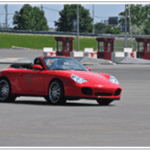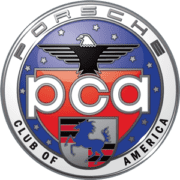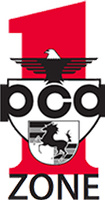2025 Schedule:
Pocono autocrossss are operated with Riesentoter and Central PA PCA regions. We very much need volunteers who can help transport, setup, test and run equipment. We also need volunteers who can come early and/or stay after to help. If you are willing to help, please reach out to me at autocross@nnjr-pca.com.
registration for all events is via nnjr-pca.Motorsportreg.com
questions? feel free to email me at autocross@nnjr-pca.com
all autocross events are all-day, and depend on everyone working as well as driving.
instruction is always available and new drivers are very welcome!
The Pocono “East” course has proven hugely popular. The East course is long — between 7/8 – 1.1/8 miles (depending on configuration), fully FIA curbed, and wonderful… Pocono East Course WOW! Autocross on a race track!
Registration and payment is via Motorsportreg.com-here. (Classing info is also linked on Motorsportreg.com.)
Car Control Clinic:
Its back! Registration is OPEN on nnjr-pca.motorsportreg.com.
The Car Control Clinic has a strictly limited number of drivers (to ensure plenty of driving time for each driver). So sign up early!
If you have any questions or suggestions for the 2024 season, send them my way, at autocross@nnjr-pca.com.
Upcoming AutoX Events
Date
Title
Color
Post Date
Time
Month Long Event (January)(GMT-05:00)
Event Details
Get Ready! NNJR event dates for 2026 are starting to take shape! Here are some of the preliminary event dates, so do not wait and mark your calendars now. Drivers Ed
Event Details
Get Ready! NNJR event dates for 2026 are starting to take shape!
Here are some of the preliminary event dates, so do not wait and mark your calendars now.
Drivers Ed
4/18 – 19 Lightning 1
4/27 – 28 WGI Advanced Solo
5/22 – 23 Thunderbolt
6/22 – 23 Lime Rock
6/27-28 Palmer (w/ another PCA club)
7/17 – 18 -19 Mid-Ohio
8/7 – 8 – 9 WGI 3-Day Instructed
10/3 – 4 Lightning 2
10/23 – 24 – 25 VIR
Rally & Off Road
Autocross Day Schedule In a Glance:
- Registration opens 8:00 am
- Walk The Course (when announced)
- Novice Walk-Through approx. 9:30 am
- Driver’s Meeting approx. 9:45 am
- First Car Off approx. 10:00 am
- End Of Day Trophies approx. 4:00 pm
AUTOCROSS BASICS
What to Expect
Before we dive into the day’s mechanics, here’s a nice video that New England Region (PCA) produced – enjoy!
NER Autocross Video – watch me!
The autocross day starts early. Organizers (volunteers – become one!) will be on site around 6AM to start creating the course, and testing equipment, but generally participants should arrive about 7:45 (unless you want to help). When you arrive, park by a friend or others with cars similar to yours. Unload your car of everything that is not screwed down, including map pockets, glove compartments and trunk. You do not have to remove your spare tire, though you may. The earlier you arrive the more time you have to put numbers on your car, sign in, get your work assignment, socialized and most importantly – learn the course!!!!
Sign-in and work assignments will open up around 8:00. In general we require pre-registration on motorsportreg.com. Get in line, know your Class /assigned car number ready. In order to provide you more drive time (runs), we sometimes limit our registration. Prices vary by event and venue, but are typically:
- PCA Members: $90 (pre-registered)
- Non-Members: $100 (pre-registered)
Pre-registration is via nnjr-pca.motorsportreg.com.
Note: the last few events have sold out online, so if you do show up, there is no guarantee there will be space for you.
The basic format of autocross is that half the group races while the other half works, and then we switch.
What you need to do before racing begins:
Check in and get your work assignment
When you pre-register, you are not only creating a registration, but selecting the class your car competes in. If you wish to drive, but not compete, you may simplify this by choosing the “FUN” class. In either case you must know your assigned class and car number.
The most important information you will receive when you sign in on site is your flagging (Course Worker) assignment . Flagging is crucial to both operation and safety, and involves reporting cones that have been hit in the vicinity of your station, replacing cones and stopping the action if an unsafe condition presents itself. Autocross only functions if we all work, making it possible for others to run! There are also specialized work assignments, including early morning set-up tasks. If you are interested, inquire weeks ahead – these take time to learn (but you will be very valuable and appreciated member of the team).
Put numbers on your car:
Using painters tape, shoe polish or any other means, put LARGE, EASILY READ numbers on both sides of your car. These must match the computer issued numbers from motorsportreg.com.
Go through tech inspection:
In most cases we have a tech line. Go through that line for safety tech once your car is empty, you are signed in, and numbers are on your car. Bring your helmet – it must be checked as well. Tech inspector(s) will ensure your car has been properly emptied, tires and suspension appear safe, your helmet meets requirements and there are no obvious fluid leaks. When you have passed tech, there will be an indicator (typically a tape mark on a headlight) that you car has passed tech and the number recorded.
Immediately after registration/check in we will announce that the course is open for walking. You should (it is really essential) walk the course. You cannot walk the course too many times. No matter how well you think you know it, it will look different through the windshield at 45 mph. Walk with other people and discuss the “line”. There will be a special walk-through for novices conducted by an expert, probably around 9:30. Listen for the announcement. Being able to walk the course several times is the BEST reason to get to the event early.
Finally there will be a driver’s meeting around 9:45. We will discuss safety and the conduct of the program. We will announce whether odd or even numbered cars will be running first. The non-running car drivers will be flagging, if they have a morning assignment. Cars that are running will be asked to bring their cars to the staging area.
Ready? Good luck!
We also recommend that you download and read “Details of a Day” (in downloads)
Autocross Day Schedule In a Glance:
- Registration opens 8:00 am
- Walk The Course (when announced)
- Novice Walk-Through approx. 9:30 am
- Driver’s Meeting approx. 9:45 am
- First Car Off approx. 10:00 am
- End Of Day Trophies approx. 4:00 pm

What should I bring?
- An appetite for fun!
- Proof of pre-registration and your assigned car number. We presume you know your name.
- The class in which you will be competing
- Helmet that meets current specification (see www.smf.org)—loan helmet are available.
- Sunscreen
- Sunglasses
- Folding chair
- Water and lunch
- Painter’s tape
- Pen and paper
- Medication, if required. If you have allergies or a medical condition that requires special care, please wear the appropriate medical alert for that condition.
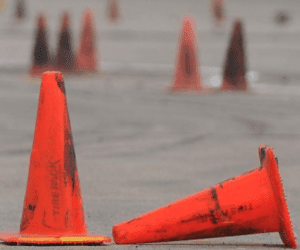
NNJR Car Control Clinic
Goals of the Car Control Clinic
The primary goal of the Car Control Clinic is to make the participants feel like they have an improved sense of control behind the steering wheel. You will accomplish this by learning the fundamentals of good car control through a series of instructional exercises designed to push the limits of the participants and their machines. The other goals – equally as important – are to BE SAFE and HAVE FUN!
The car control exercises are purely designed for the sake of learning. There are no timers at this event, and there are no winners or “results” of any kind. The speed of the participants’ automobiles is only important as it relates to being able to properly get something out of the exercise. For example, to properly learn the braking exercises, the car must be traveling at sufficient speed to allow for ABS to be triggered.
The exercises are designed to be followed closely by the instructors so that we maintain continuity in the way these skills are taught to the participants. Please take the time to review each exercise carefully as described in this manual.
https://nnjr-pca.com/wp-content/uploads/2024/04/2024-CCC-Student-Guide.pdf
Basics of the Day
Before you leave home, be sure you pack
- your helmet (if you don’t own one we have a few loaners),
- sun block
- lunch
- plenty of water
- chair optional
While there is no pre-event tech required (your car will be checked out at the event), be sure you have sufficient rubber on your tires, have the tires inflated to factory spec, and have a full tank of gas.
Plan to be at MetLife Stadium, Lot L no later than 8:00 AM for sign-in.
Students will be divided into two groups – AM drivers and PM drivers. While the one group drives the other will work, and vice versa. The running groups will be distributed among various exercises: three different skidpads (at least one clockwise, one counter-clockwise), a braking exercise, and a slalom exercise. After the groups complete each station they will move to the next with their instructors.
We expect to be finished by around 4:00 PM, which allows for a short lunch break.
Preparing the Car at the Event
You should take a few minutes when you first arrive to make sure that your car is prepared for the day. All floor mats should be removed, as well as any loose objects from the trunk(s), glove box, or center console. You may want to bring large plastic garbage bag to hold everything, especially if it looks like rain.
There should not be any equipment affixed to the windshield or other glass of the car such as cameras, radar detectors, or EZ Pass badges.
Throughout the day, continue to take note of the car and the condition of the tires. If anything concerns you about your car, do not hesitate to discuss it with your Instructor.
Preparing Yourself
When you first sit in the car, take note of your driving position. Your arms should be able to comfortably hold the wheel at the 9 and 3 o’clock positions with a slight bend at the elbows. Your legs should also be able to fully depress the pedals without “locking” your knee.
Please note the importance of being smooth on the controls of the car – the steering wheel, shifter, gas and brake. The exercises will reinforce smoothness, one of the most important aspects to improved driving, and something you should keep in mind throughout the day.
The course was designed with your safety in mind. If you are going to wiggle or spin, this is the place to do it safely! Relax and to have fun!
Exercises Skidpad
We will be running skidpad exercises, one session clockwise, and the other counter-clockwise. The courses will be watered down by a fire
truck. The wet pavement makes the “breakaway” speeds slower and creates much less wear and tear on the tires.
The objective is to get the student to feel the car at its limit of adhesion. It starts by having the student drive the car in a steady circle reasonably close to the cones, and then gradually increasing speed to the point where they are steering with the throttle ONLY (i.e. no steering wheel input.) This is much harder than it sounds! As the student increases their throttle input, their car should start to under steer more, pushing them further from the cones and making the circle larger. As they reduce their throttle input while keeping the same steering wheel angle, their line will become tighter and the circle will become smaller.
Another critical teaching point to this exercise is the concept of ‘ocular driving’, sometimes called driving with your eyes. The student is instructed to look far ahead through the circle, half way across, if possible. Their head should remain fixed like their steering wheel. This illustrates how important ‘looking ahead’ is in driving. You will feel a greater sense of control once you have mastered these two main points of the exercise.
If the student spins, that is ok, though not the objective. We want to be pushing the limits throughout these exercises, and challenging the students to see what the ‘other side’ of the limit of adhesion feels like.
The entire exercise should be run in second gear, unless the gearing is not sufficient to get the car up to the necessary speed on the skidpad. Between runs, instructors will reinforce what the driver and car did on the last run.
Braking Exercise
The objective of the braking exercise is to get students to use 100% of the brakes available in their car. Most won’t come close to fully using the brakes on the first try. If your car is equipped with ABS you should squeeze on the brakes until you feel resistance (i.e. don’t jump on the pedal), then gradually push very hard. You may be hesitant to get on the brakes fast enough, or push hard enough. Your instructor will help you overcome this. You should use the same technique if you have non-ABS brakes, except that you will have to be ready to modulate the brake pedal to avoid lockup.
There are a couple of very important aspects to this exercise. First, you will need to accelerate briskly from the start point (although it is not intended to be a drag race), and continue building speed until you
approach the first turn. This first braking zone is part of the exercise as you should only slow the car enough to make the turn. Your instructor will help you not over drive this slow turn by coaching you to brake hard enough and soon enough. Instructors may also discuss the concept of the ‘slow in, fast out’ approach to turns.
Another important aspect to this exercise is the concept of squeezing the brakes – even under hard braking – rather than stabbing the brakes. When the brakes are applied by stabbing or stomping on them, even with an ABS car, the weight transfers almost completely to the front tires unsettling the car and reducing braking capability and overall control. However, when we use smooth but firm brake input, we achieve better weight distribution under braking and use the available contact patch of all four tires more efficiently.
Slalom
Slalom is all about using the steering wheel and looking ahead. You will be encouraged to start out slowly and maintain a steady, comfortable pace throughout the entire course. Instructors will focus more on form as you gain the sensation of looking ahead while correctly turning on the backside of each cone.
The goal is to cross the imaginary line between cones as early as possible to set up for the next cone and turn. The most effective way to do this is to start the turn early at the first turn in the slalom, carefully pointing the car across the middle line while almost running over the “back” of the cone being passed. We don’t want to see lots of cones destroyed, so you should gradually increase speed while staying close to but not hitting the cones.
The turnaround at the far end of the course is another ‘slow in, fast out’ turn, which is easy to miss. You will get a good feel for how your car turns and transitions when alternating inputs (left turn, then right turn) are introduced. Again, smoothness of inputs (shifting, steering, braking, and throttle) are emphasized.
More advanced drivers participating in the Car Control Clinic may also notice, especially if they have already done one of the skidpad exercises, that the line of the car through the slalom is affected by the throttle input. More throttle will generally cause the car to under steer (push), while a throttle lift mid-corner will help the car turn and may induce some overseer, thus reduce the amount of steering wheel input required. This ‘throttle steering’ technique should generally be tried by more advanced students.
Autocross FAQ’s
I’m a first timer. What can I read first?
Every event has many novices, usually 30% of the Porsche drivers. All novices and veterans alike are there to have fun and help one another. Like tennis and golf, you will get better at Autocrossing the more you do it. Reading about it in PORSCHEFORUS will NOT improve your driving.
There are books on Autocrossing that are worthwhile (a great one is Solo Racing by Henry Watts), but are no substitute for getting started. Read more about our events on this website, including your proper car class. We have a novice category in each car class. We can’t guarantee that you won’t embarrass yourself, but it won’t be because of your performance in your car!
The best thing to read first are the “AX basics” tab on this site, and the resources under “AX documents”.
How much does Autocross costs?
Prices vary by event (test ‘n tune, Autocross, school, etc.)
We are listening to you, and working to give you more runs in a day, this means fewer people and marginally higher price range:
$90 for NNJR Members
$100 for nonmembers
Are spectators permitted at NNJR Autocrosses?
Yes, spectators are permitted but they must stay in designated spectator areas to assure their safety. All spectators nad guests MUST sign the insurance waiver and wear a wristband. There is no fee.
Do i need to pre-register for an Autocross?
Yes, pre-registration is mandatory through Motorsportreg.com, up to two days before an event. Payment is also collected through Motorsportreg.com. This registration drives numbers, classes and therefore the timing computer. You MUST have the number assigend in Motorsportreg.com on your car.
Can non-Porsches participate in NNJR Autocrosses?
Yes, Non-Porsches are warmly welcome. There are many non-Porsches at each event. But arrive early, because non-Porsche registration will be cut off when total registration reaches a predetermined number (depending on venue).
Can minors participate?
Minors, 17 years old, may participate with their parent or guardian in attendance.
Can two drivers share a car?
Yes, but each must register, pay the entrance, work and have a unique car number.
What do i need to bring? Do?
For a LOT more info see the section “typical day”. You don’t need much – just a car ( stock is fine), well checked out (see the tech form), food, water, helmet (loaners are available), and convenience items. Cars need little preparation for FUN! or stock classes – make sure tires are factory +2lb to start and ask around.
Also read about the basic rules of autocross, and familiarize yourself with work assignments. If you dont know what is expected of you you WILL slow things down, crate timing errors, or even create a safety condition – so please read up! A worker manual is being written and will be (it may be there when you read this) on this site, under “Autocross/documents”.
Do i need to specially prep my car?
No. In fact there is real benefit to driving your car just as you drive it every day. You should ensure that the tires are in good condition and properly inflated (start with factory and experiment). All mechanical bits should be tight. You must empty your car (including drivers floor mat) when you race. Completely.,
Is Autocross safe?
Yes! As a new racer, if you follow instructions and use good judgement Autocross is very, very safe. In fact much safer than driving on public roads.
But if you break the rules and don’t pay attention, bad things can happen.
We set the course to avoid hard objects. Cars are spaced by 20 or more seconds and cannot therefore collide. The course is defined by rubber cones. You will generally be under 50 mph, with brief speeds up to 70 if you are good….. (although it may feel like 120).
The two most important things to do are 1 drive within your limits and 2) pay attention when you are working the course!
relax, enjoy.
Will i damage my car?
…not if you use good sense and listen to instructors. For example, i race the same car i drive every day. I have the same (competition rated Bridgestone RE-71R) tires on it after 3 years of racing and street driving. Compared to track use its very easy on cars.
Can my son/dusghter/friend ride with me?
Insurance requires that if two people are in a car one must be an approved instructor. So, generally, no. Anyone in a car must also be a registered driver (or registered volunteer instructor).
When must I arrive? When can I leave?
1. Arrive early to prepare, register, get your work assignment and walk the course — learning it several times. The course is > mile long so this is not a quick process!
2. Autocross works because we all work. When you are not driving, you are working a corner (or being a starter, timer, etc.) So everyone must stay to the and, typically 3:30. If you can stay later and help pack up it is greatly appreciated.
Bottom line: plan top stay the day.
Is food available?
No. There is no food convenient, and no time to head out to get food. So please bring everything you need – water, lunch, etc.
NNJR Autocross Operating Rules
Remember: all Stock and Production cars, and this means 90% of you, must have tires with a wear rating of 140 or greater.
- Each driver must wear an “M” or “SA” rated helmet carrying a 2015 or later Snell Memorial Foundation approval sticker. For those purchasing a new helmet, a 2015/20 “SA” rated helmet is strongly recommended, but an “M” rated helmet is acceptable. Loaner helmets are available for new drivers. You MUST purchase a balaclava (disposable liner) to borrow a helmet.
- All NNJR Autocross events are FULLY MUFFLED EVENTS. Any car having a noisy exhaust system will be rejected.
- Metal-to-metal seat belts, securely anchored are required. 1965-68 “900 Series” cars must modify the outer seat belt anchors so that the belt crosses the pelvic bone and lower abdomen and down toward the anchor point as near to a 45 degree angle as possible.
- Sneakers, tennis shoes or other rubber-soled shoes are recommended. High-heels, sandals and the like will not be allowed.
- Roll Bars are recommended for all open cars.
- Fire Extinguishers are not mandatory but recommended. For those cars equipped with fire extinguishers, the extinguisher must be a minimum of 2.5 pounds, BC or ABC rated and fully charged. It must be fastened to metal using metal brackets and fasteners, within reach of the driver while buckled in the driver’s seat.
- Tire and wheel combinations must be completely covered by the bodywork and have sufficient clearance to prevent rubbing that could be considered to be dangerous.
- You must retain a Porsche OEM engine block or case (except for X class).
- All drivers must read, print and sign the tech form (available on the documents page). All cars must pass an on-site safety inspection. All loose articles must be removed prior to the safety inspection. Having the car inspected is the responsibility of the driver. A car that has not been inspected will not be allowed to compete. Late inspections are at the convenience of the Tech Inspectors.
- Cars /drivers not following the series rules will be subject to protest. Protests which are upheld may result in disqualification from the event, reclassification or other changes as determined by the event chairperson.
- A driver may only enter one (1) car in an event. A maximum of two (2) drivers are allowed per car. Co-drivers of the same car may be asked to run in opposite heats.
- In accordance with New Jersey law, absolutely no passengers are allowed at any time, except for pre-approved NNJR instructors. If an instructor drives your car for a run, the time will not count, and you will receive a re-run.
- All rules are the same for Novice and Veteran classes, except for tires (see below). New autocrossers with fewer than three (3) events of experience will have an instructor provided (mandatory) for their first run of the day. Instruction is available (and encouraged!) for all participants throughout the event.
- All drivers must have a work assignment at a flagging station or other duty assigned. Any driver who does not show up for their work assignment may not be allowed to drive, or may forfeit championship points, at the discretion of the event chairperson.
- NO ALCOHOLIC BEVERAGES OF ANY TYPE MAY BE CONSUMED BY ANY PERSON DURING THE DRIVING EVENT. THE USE OF ANY ILLEGAL OR REFLEX AFFECTING DRUGS IS STRICTLY PROHIBITED.
CAR CLASSIFICATION
Rule #1: If all this classing stuff seems too complicated – just sign up for
“FUN” and cut directly to the driving part.
General Overview of Class Structure
Please refer to classing document listed in the registration for any given event, this page provides an overview.
We provide a linked classing document for each event. We also provide a classing document in the downloads – but it may or not be the same set of classes used for some specific events – so try to use the document linked on motorsportreg.com
Cars are placed into classes so that cars of approximately the same capabilities compete with each other.
Classes carry a “PAX” which is a form of handicap and allows drivers in two classes to compare runs more fairly – e.g.: faster cars are proportionally adjusted compared to slower cars by a percentage (e.g.: time x 0.95 for a faster car vs time x 0.9 for a slower car).
NNJR has an open policy to encourage participation by our friends, family members and SCCA competitors who do not drive Porsches. We call this “X” class and is open to any brand car that meets our safety requirements. We often run SCCA classes for non-porches, when we can.
Stock (S1, S2 …) is designed for cars with no modifications. The NNJR classification philosophy is for Stock classes to only allow minor changes, of the type commonly made by performance-minded Porsche owners.
Production (P1, P2) is designed for cars with sum common modifications but excludes major changes such as suspension TYPE or engine block/displacement – major modifications fall into “modified” and “improved”. Often — common street modifications such as brake pads, shock absorbers, and tire size are allowed. Again see the classing worksheets for details.
Improved and Modified classes are designed primarily for cars with significantly improved suspensions. The Modified class is for cars with significant changes, such as lightweight bodywork modifications and engine swaps. Modified cars must maintain the same levels of essential equipment as a “street” car, however including headlights, taillights, turn signals, a windshield and all glass (Lexan or similar is acceptable as replacement as long as it is clear), body panels (original or replacement)
X Class cars will be classed and paxed according to current SCCA Class and Pax Classifications.
Mis-classification can be protested. Use or deletion of any equipment not covered in these rules that, in the opinion of the Event Chairperson, results in increased performance will move the car into the next higher class (Improved or Modified). PROPER CLASSIFICATION IS THE RESPONSIBILITY OF THE ENTRANT.
Categories
There are four categories of classes – Showroom Stock, Production, Improved and Modified. Categories are related to automobile configuration.
The Showroom Stock (S) Category contains classes of automobiles as normally delivered and specified for use in the United States and Canada. Factory options as normally available for a specific model year are permitted. Certain factory and/or dealer installed equipment/ options will move an automobile out of S and into Production or higher as specified in the Modifications Allowed List table so as to maintain the intent and integrity of the Showroom Stock classes.
The Production (P) Category contains automobiles (as normally delivered to the United States and Canadian public through authorized sales outlets of the manufacturer) plus others with limited performance-affecting changes from stock. The Improved (I) category contains automobiles with more substantial performance-affecting changes from standard (stock) specification, whether changed by the factory, dealer or owner. These modifications have defined limits. These automobiles are classed according to their number of cylinders and actual displacement.
The Modified (M) Category contains automobiles that have performance-affecting modifications outside of the limits of the Improved category and for race automobiles (factory-built or otherwise). These automobiles are classed according to their specified number of cylinders and actual displacement.
Below is a list of resources – especially useful for new autocrossers.
Choosing a Class:
The classing worksheets simplify the process of finding you car’s proper class. Classes let you compete with others that have similar cars. It also provides a “PAX” that attempts to provide even competition between faster and slower cars. If you don’t care about your PAX (its like a handicap) and want to simplify, just pick “FUN”.
Classes are updated periodically. The most recent classing worksheets and information are included in the registration data on motorsportreg.com — where you go to sign up and pay for events.
Work Assignments:
Autocross only succeeds, because we all take on a work assignment when we are not driving. These assignments may be running timing equipment, organizing cars on the grid, resetting cones, or watching carefully and calling in infractions. The bottom line is doing them right is critical for the best experience, and for safety. One of our biggest problems is new drivers who don’t understand what to do when they are working – this causes delays (less driving), can be dangerous, and really annoys your fellow racers.
NNJR Autocross Forms and Documents
(Please also see Autocross Basics.)
Background Information on Autocross
- Secrets of Solo Racing: Henry Watts: One of the best books on Auto-crossing (with plenty of info for Track/DE as well!). Note, we have no affiliation with Mr. Watts nor with Amazon; it’s just a great read.
Map of meadowlands parking lots. We typically run in J, L or E:
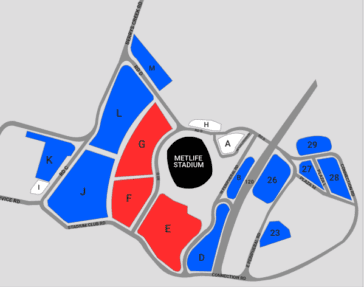
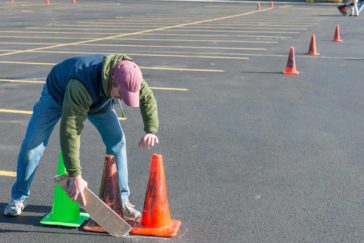
2025 Season
Below are the results for our events held at Pocono during 2025.
Note that we no longer provide an overall ranking based on PAX times since they have not been updated in some time and some feel they are no longer entirely representative.
For each event we present raw data (al your times); final results; and a summary of results by class.
Note that due to the way we pax (built into Axware, our software) and the very large differences between PCA and SCCA paxes, the ranking implied in some reports is misleading. Fundamentally SCCA paxes are much lower than PCA paxes, so those with an SCCA PAX modifier show up at the top of the leaderboard and those with PCA pax modifiers — at the bottom. So don’t try to read much into those.
June 2025 event results:
July 2025 event results:
August 2025 event results:
September 2025 event results:
2024
Results for July 21 2024 Autocross @ Pocono
Results for August 25 2024 Autocross @ Pocono
Results for September 15 2024 Autocross @ Pocono
2023
June 4 2023 – Pocono Autocross
Here are the results for the aut0cross event last Sunday. Note that the PAX results are specifically limited to Porsche simply because all SCCA PAXes are lower than any PCA PAXes – they cannot be compared
July 2 2023 – Pocono Autocross
Here are the results for the aut0cross event last Sunday, 2nd July. Note that the PAX results are specifically limited to Porsche simply because all SCCA PAXes are lower than any PCA PAXes – they cannot be compared.
- RAW results
- A”FINAL” results
- PAX results (allows comparison between classes, with some limitations)
- ALL PAXes (useful mostly to compare SCCA PAXes)
August 6 2023 – Pocono Autocross
I have corrected the errors that several of us noted in the previously posted (but not announced) results.
Here are the results for the aut0cross event last Sunday, 6th August. Note that the PAX results are segregated by Porsche-SCCA-FUN because all SCCA PAXes are lower than any PCA PAXes – they cannot be compared, and FUN and AUDI have no PAX (raw times multiplied by 1.000). So they are ranked within those categories.
- RAW results
- “FINAL” results
- PAX results (allows comparison between classes, segregated PCA/SCCA for apples vs oranges)
- Summary Results
– Grant
2022
Results for Fathers Day / Juneteenth Autocross
June 19, 2022
Pocono Raceway
Below are the Final, Raw and Pax reports
Also attached are “SCCA PAX only” and “PCA Pax only” (including FUN and ACNJ)
These are provided because the SCCA Paxes are vastly lower than PCA paxes and cannot be fairly compared. These two reports group apples with apples and oranges with oranges.
Pax june 19 22-PCA & ACNJ only
Results for Sept 24 2022
Pocono Raceway
Below are the Final, Raw and Pax reports
Also attached is a spreadsheet with “SCCA PAX only” , “PCA Pax only” and ACNJ
These are provided because the SCCA Paxes are vastly lower than PCA paxes and cannot be fairly compared. These reports group apples with apples and oranges with oranges.
2021
September 12th Autocross results
Below are the results of September 12th’s Autocross at Pocono. Note that Porsche and SCCA PAXes are very different, and SCCA PAXes are always substantially lower. Therefore they cannot be compared. I have created individual sheets that rank PCA (incuding FUN) and SCCA independently. Enjoy!
Congratulations to our FTD – Rick Newman followed by 0.1sec by Lou Hudyman.
July 25th Autocross results
Below are the results of May 8th’s Autocross at Pocono. Note that Porsche and SCCA PAXes are very different, and SCCA PAXes are always substantially lower. Therefore they cannot be compared. I have created individual sheets that rank PCA, SCCA and FUN independently. Enjoy!
https://nnjr-pca.com/wp-content/uploads/2021/07/Results-FUN-class-no-pax.pdf
https://nnjr-pca.com/wp-content/uploads/2021/07/PAX-results-PCA-Paxes.pdf
https://nnjr-pca.com/wp-content/uploads/2021/07/PAX-results-SCCA-Paxes.pdf
Below are the results of May 8th’s Autocross at Pocono. Note that Porsche and SCCA PAXes are very different, and SCCA PAXes are always substantially lower. Therefore they cannot be compared. I have created a Porsche-PAX-only list which allows different models and years. Enjoy!
2020
July 19th Pocono NNJR-RTR-CPA Results (HTML)
2020_07_19_pocono_autox_summary

